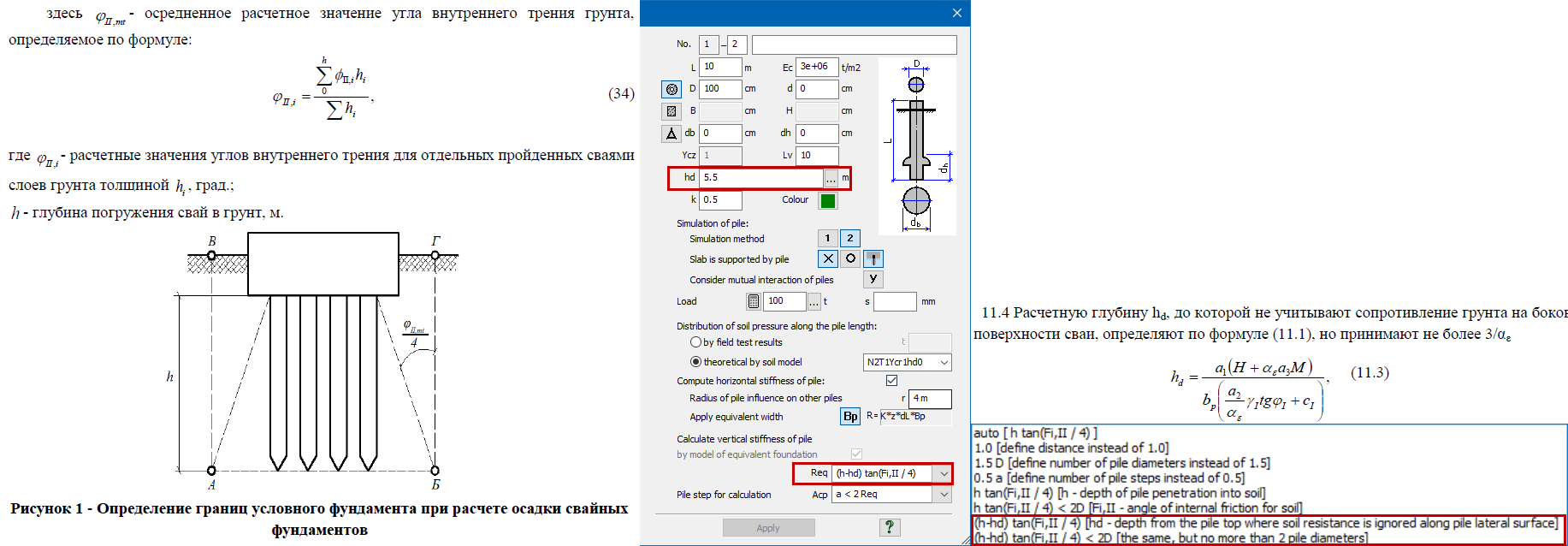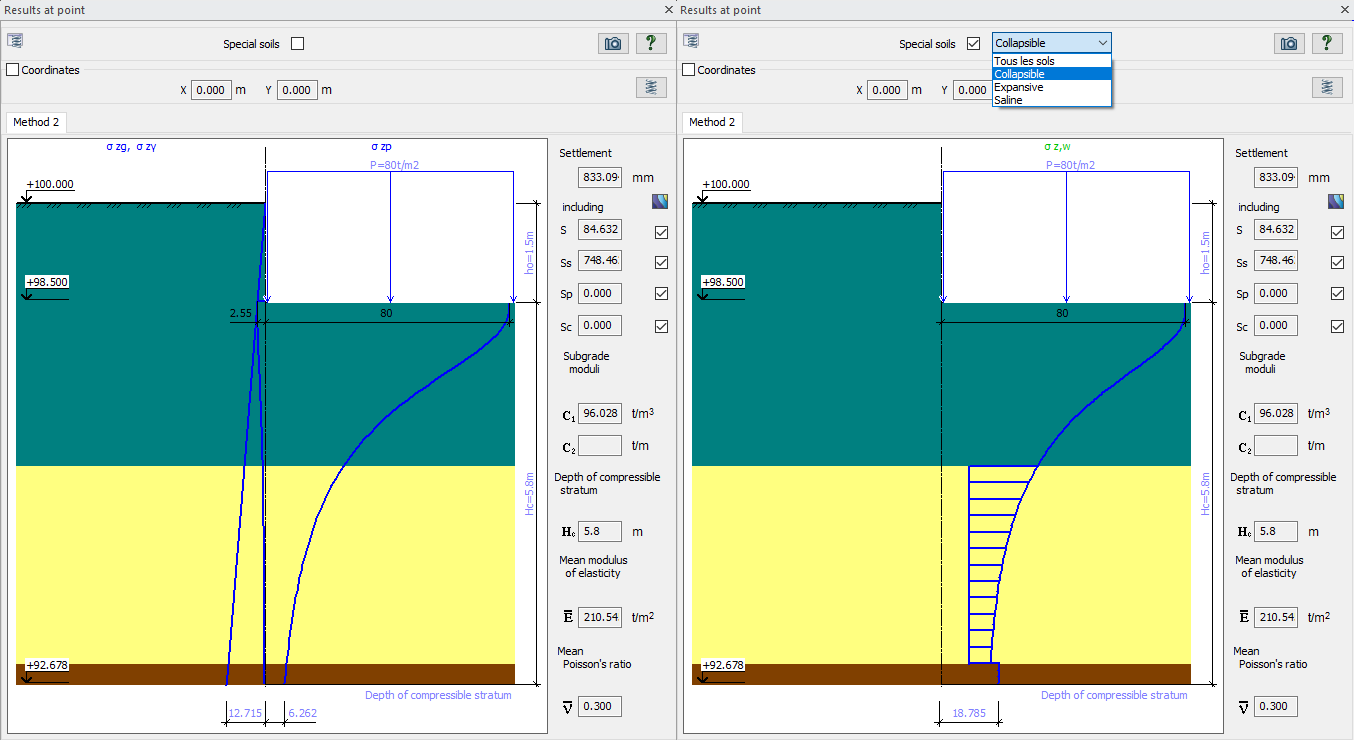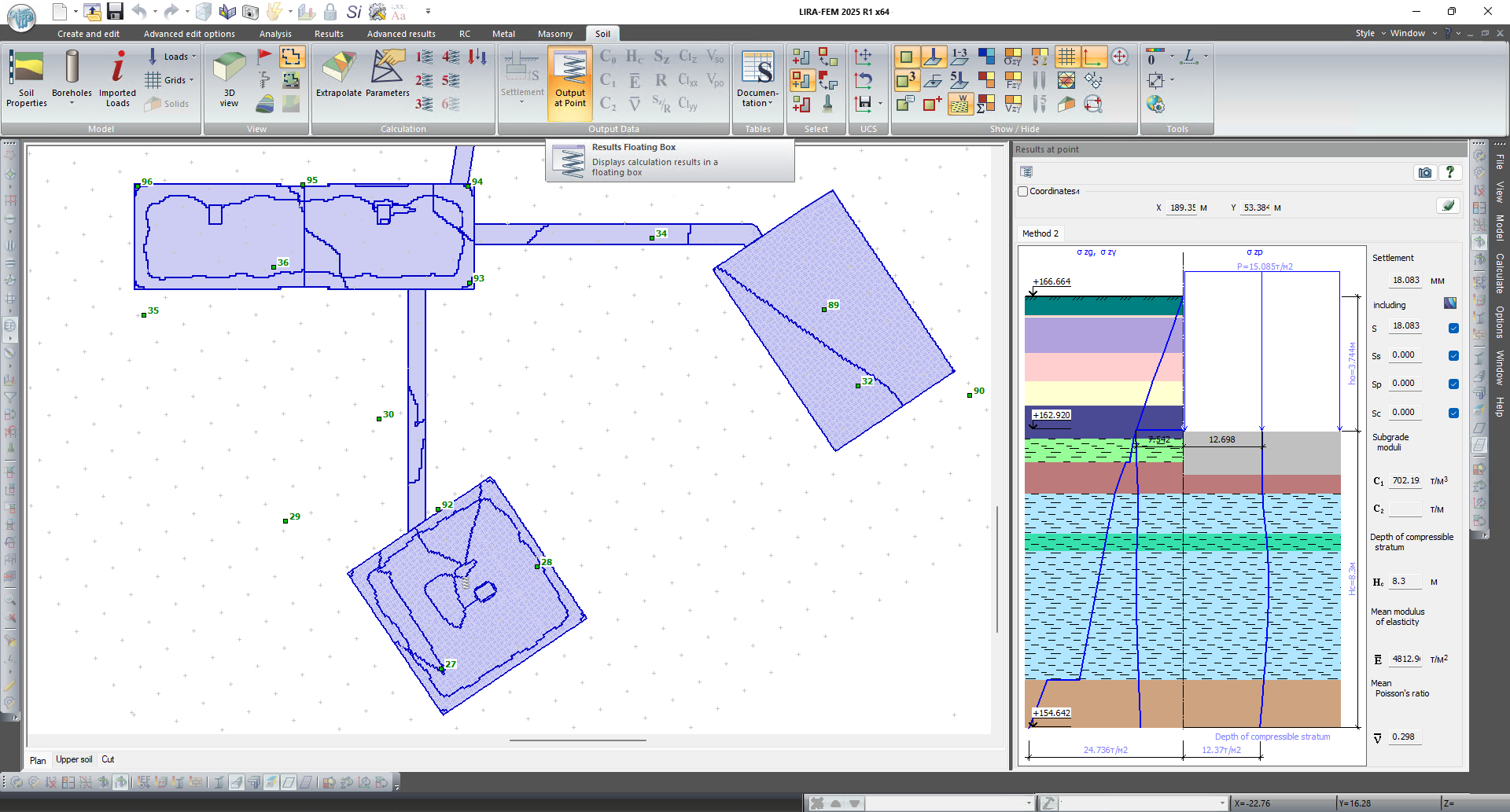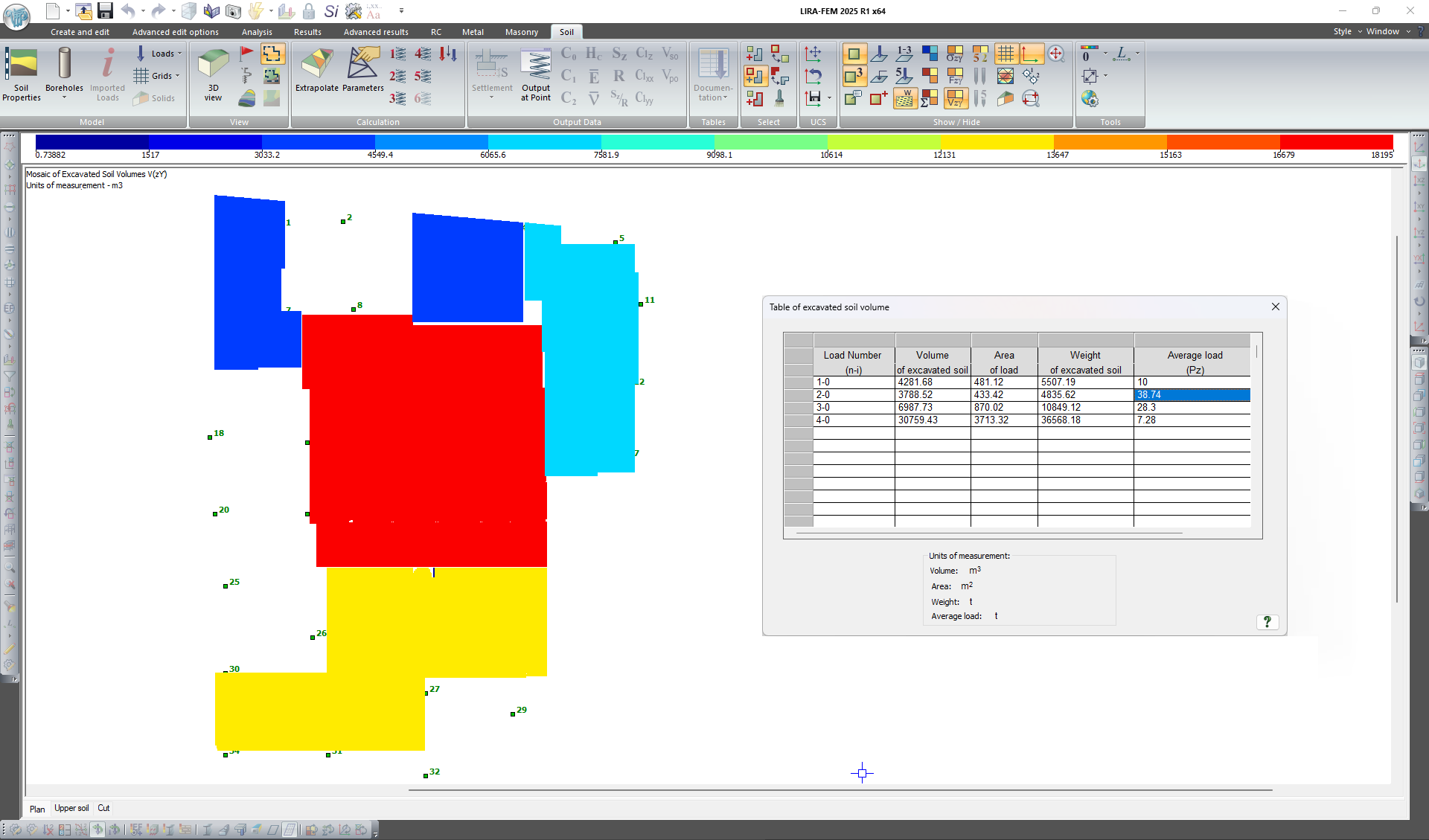VERSION HISTORY
LIRA-FEM
Soil
-
New options for generating Equivalent Foundations for piles have been implemented: when calculating Req using the formula h*tg(θII/4), where h is the depth of pile penetration into the soil, the effect of the depth hdЧat which the load-bearing capacity fi of the pileТs lateral surface is not taken into accountЧhas been added. Moreover, if the parameter Уh-hdФ results in a value of Req less than 0.5D (half the pileТs diameter), then Req is set to 0.5D.
- In the "Results at a Point" dialog box, an option has been added to display calculation results for specific soils. This visualization allows for examining calculation details, serving as a partial trace of the computation. For example, for settlement soils, a hatched area of the full stress diagram Sz is shown, which contributed to the settlement calculation due to consolidation Ц clearly showing the initial settlement pressure and the extent to which the total stress Sz exceeds the initial settlement pressure layer by layer. Keep in mind that the total stress Sz includes the weight of the settlement soil with the buoyant effect of water taken into account, although in the original calculation without settlement the soil was treated as undrained (waterlogged). Thus, on the new diagram for calculating the specific soil under the foundation of the settlement layer, a jump in stresses is visible that is absent in the calculation without settlement.
- In the scale settings, an option has been added to display percentages in the scale ranges Ц indicating what fraction of the original data points and computation results fall within the given range.
- In the legend (textual accompaniment) for the calculation results (settlement and subgrade coefficients), the average value calculated from all load contours is now displayed.
Improvements to the "Soil" module
Calculation of settlement to check the serviceability and determine the design resistance for foundations according to EN 1997-1:2004. Vertical soil stresses σz at depth z are calculated based on the Boussinesq approach and the superposition principle.
The natural pressure diagram is clarified in the case when the cushion is a load and the cushion is above the relief level.
A new algorithm is implemented for calculating settlement and stress values at a specified point of the soil model, without the need to perform a complete analysis.
New option to assign the order of boreholes in the list of boreholes.
For boreholes, it is possible to define a borehole legend (designation).
To estimate the initial expenses and volume of excavation operations, new mosaic plots for the weight and volume of excavated soil were created.
New table that displays load parameters (volume, area, weight of excavated soil, and average load value).
New flag of drawing Triangulation mesh for generation of contour plots.
A mosaic plot for groups and subgroups of loads is added to check the input data.
Improvements to the "Soil" system
-
New method for calculation of subgrade modulus (Method 6); it is based on experimental data on the velocities of elastic wave propagation in soil layers located below the foundation base. The method is implemented according to NTP RK 08-01.2-2021. For the details, see the Knowledge Base.
-
New calculation of the bearing capacity of piles with account of earthquake loads according to Section 11* of SP RK 5.01-103-2013 (rev. 2021).
-
Added input data and algorithm for analysis of piles "Electric power line supports".
-
Enhanced calculation of bored and drilled piles with bells in sandy soils:
- If a pile with a bell cuts through a sandy soil layer, then a region of the side surface of the pile with zero soil resistance may appear above the bell. In the previous version, it was assumed that this area always appears when the pile cuts through the sandy soil. In the new version, this region appears only when the sandy soil is located above the pile bell within the height of an imaginary cone made by a line that touches the surface of the pile bell at an angle of φI / 2 to the pile axis. (φI is the angle of internal friction of the soil.)
- When the height of this cone is calculated according to SP RK 5.01-103-2013 for the "spherical" shape of the pile bell, if dh < (db-D)/2 is specified, then now dh=(db-D)/2 will be accepted in the calculation.
-
Optimised function for splitting the imported loads into load subgroups (required for correct determination of the design resistance of the soil R for individual foundations).
-
For specific soils (expansive/swelling soils), the shrinkage zone Hsh (defined in the load parameters) is now always measured from the relief surface (more precisely, from the starting point of the diagram for the soil dead weight, i.e. if the "Account of soil weight above elevation of load application" check box is selected, then Hsh will be measured from the relief surface). Thus, if the shrinkage zone Hsh =5m and the foundation depth is 2m, then the shrinkage depth from drying of the expansive/swelling soil will be only 3m and only from the total stresses under the foundation base. And if the specified Hsh is less than the foundation depth, the settlement from the deformation at drying out of the swelling soil will be equal to zero. A detailed description of this calculation is available in the Knowledge Base.
-
In all tabs of specific soils in the "Soil Properties" table, it is possible to arrange the P values (pressure) and nominal strain in ascending order. To avoid confusion in the calculation, you should always try to set this data in ascending order.
-
If the swell shrinkage parameters (pressure-shrinkage) were specified with a single row (i.e., without the row 0=0), then linear interpolation is used to determine the pressure-shrinkage parameters from zero up to the specified values. If the active pressure exceeds the user-specified pressure, the last (user-defined) value is then considered a constant. Previously, for all shrinkage values from zero (including zero stresses), the single defined row shrinkage-pressure was assumed to be constant.
-
When there is an overlap of loads with the "Results" attribute:
- in the "Results at Point" dialog box, the results for the top load will be displayed.
- in case there are piles, the elevation of the pile head is considered as the elevation of the load.
-
"Results at point" dialog box. When generating diagrams and dimensions, the contrast colour is determined automatically depending on the background colour defined by the user in the input data.
-
A "Geometric properties" buttons are added to the "Soil" ribbon tab on the "Tools" panel. You can use these buttons to measure distances, angles and areas in the SOIL system (the last option on the submenu, "For selected elements" enables you to calculate the areas of selected loads).
Improvements to the "Soil" system
-
Calculation of modulus of subgrade reaction C1/C2 for inclined slabs and bars.
-
The table of soil properties is expanded with properties for analysis by ultimate limit state (ULS); they are used to compute bearing capacity. Soil properties for analysis by serviceability limit state (SLS) are used to compute settlement and stiffness. The confidence level α is taken as equal to 0.85 for analysis of foundation base by SLS and 0.95 for analysis of foundation base by ULS.
-
Calculation of pile stiffness by SP RK 5.01-103-2013 is implemented.
-
In the SOIL system, it is possible to define a low-compressible/unstable soil. If the pile is rested on such soil, the pile should be considered as a post.
-
The method for automatic filling in the values of the proportionality constant is changed. The constant of proportionality is used to calculate the horizontal stiffness of piles. For SP RK 5.01-103-2013, it is possible to select the table for proportionality constant.
-
The calculation of pile bearing capacity for sandy loam at plasticity number Ip≤4 is clarified.
-
For pile foundations of bridge piers, the calculation of the design resistance of soil under the bottom end of bored and drilled piles and shell piles is clarified.
-
To generate an equivalent model of pile foundation, it is possible to select additional options Req has been added: h tg(Fi,II / 4) and h tg(Fi,II / 4) < 2D, where h and Fi,II are respectively the depth of pile penetration and the angle of internal friction. For the calculation according to SP RK 5.01-103-2013, the value h tg(Fi,II / 4) is taken by default.
-
New option to set the water table level as the borehole properties as an alternative to manually separating properties of geological element (GE) above and below the water table.
-
New option to transfer the active soil pressure Pz at the bottom face of the slab rather than at the middle of the slab/shell.
-
For all methods for calculation of elastic foundation, there is an option of not calculating the C2 modulus. This option is available in the settings for calculation in the SOIL system and in the "Soil model" dialog box.
-
Imported loads that do not have common boundaries may be automatically divided into subgroups of loads. For example, for correct calculation of design resistance R for stand-alone foundations.
-
In the SOIL system, mosaic /contour plots and screen shots with soil model are displayed with their names to easily document the input and output data.
-
When the output data is displayed, the name of mosaic plot for design soil resistance R, etc. contains the appropriate elevation.
-
New option to select the value of the load factor for soil in pullout load to determine the bearing capacity (relative) of piles.
Note. In LIRA-FEM program, when calculating the bearing capacity of piles (FE 57 both for single piles and for pile groups with account of mutual influence), their bearing capacity Fd (with account of seismicity)/ Fdu (without account of seismicity) is calculated.
-
New mosaic plots are implemented to evaluate the bearing capacity of piles according to calculation results:
- Mosaic plots for the bearing capacity of piles in compression/pullout load with/without earthquake (relative);
- Mosaic plots for load on pile Qх/Qy/Q;
- Mosaic plots for pile pressure on the soil along the side surface σz,х/σz,y/σz
-
For some specific soils (collapsible, saline) and consolidation analysis, the stresses from the weight of soil excavated from the pin are now taken into account.
-
The search for the lower boundary of the subsidence zone (the point of intersection between the total stresses and initial subsidence pressure) is clarified. If the total stresses under the foundation base are less than the subsidence pressure, then the search for the possible lower boundary of the subsidence zone continues along the entire height of the subsidence zone.
-
Clarified calculation of self-weight stresses for specific soils in case the weight of soil excavated from the pin should be taken into account.
-
Clarified calculation of expansive soils for which the height of the shrinkage zone Hsh now starts at the soil level.
-
Mosaic plot for loads with account for overlapping load areas.
-
New option to display the properties of constructed soil (soil cushion) on a cross-section.
-
In the "Results at point" window, new option to display the elevation at the bottom of the pin and the base of equivalent foundation.
-
New control when the loads from excavated soil are overlapped to more than 0.5% of the area. Previously the calculation was not allowed when the loads of excavated soil were overlapped to more than 1% of the area.
-
For imported loads, new option to display the name and path of the appropriate *.lir file, as well as loads imported from *.dxf and *.spf files.
-
In the load properties, now it is possible to write a comment.
-
New option to organize the load subgroups.

















